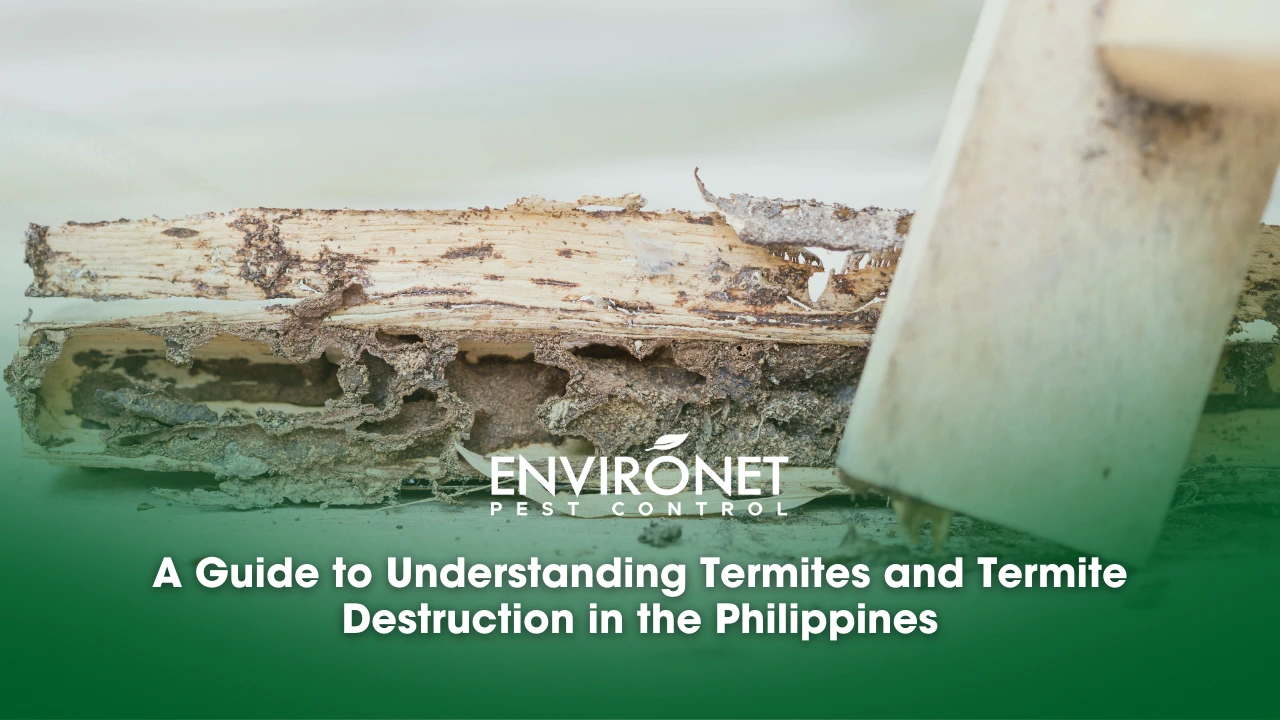
A Guide to Understanding Termites and Termite Destruction in the Philippines
Last updated on May 10th, 2025 at 01:38 pm
Termites are one of the most destructive pests that homeowners in the Philippines face. The warm and humid climate in the country provides the perfect environment for these pests to thrive, making it important for homeowners to understand termite problems and how to prevent and treat termite infestations.
Termites are often referred to as silent destroyers and structural pests because they can go undetected for a long period of time, causing extensive structural failure or damage and leading to costly repairs before their presence is noticed. They work in hidden areas, such as within walls or under floors, and can cause damage to the structure of a building without being seen. This is why it is essential to take steps to prevent termites from entering your home.
In this guide, we will provide you with all the information you need to know about termites, including the different types of termites, how termites cause destruction, damage caused by termites, the signs of an infestation, how to protect your home or building, the steps you can take to prevent termite infestations, the treatment options available, and the importance of professional termite control and management.
What are Termites?
Termites are small insects that feed on wood and other cellulose-based materials. They live in groups called “colonies” and work together to build nests and tunnels. They are also considered social creatures because they have communication and division of labor.
Termite Life Cycle:
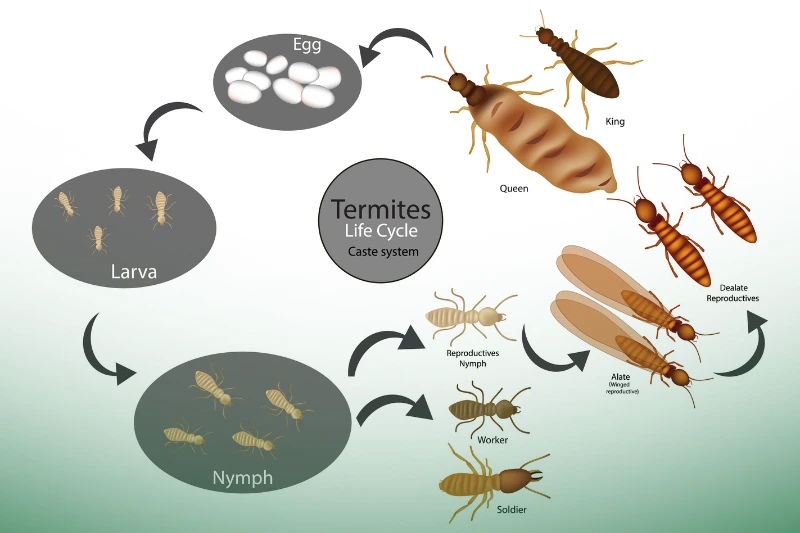
Egg – Larva – Nymphs – Termite Workers/Soldiers- Alates – Queens and Kings
1. Reproductives (Queen, King, Alates) – Their tasks are to reproduce and control the colony.
2. Termite Workers – Their tasks are to gather food sources, build shelter tubes, eat dead termites, and feed the other termites.
3. Termite Soldiers – They exist for the colony’s defense.
Termite Colony Facts:
1. A termite colony can contain anywhere from a few hundred to millions of individual termites in a termite population, depending on the species and the age of the colony.
2. Most termite colonies are made up of different castes, including worker termites, termite soldiers, and reproductive termites. Each caste has a specific role to play in the colony’s survival and reproduction.
3. Termites are highly organized and social insects, with a well-defined hierarchy and communication system in their own termite colonies. They use pheromones and other chemical signals to communicate with each other and coordinate their activities.
4. In some species of termites, a termite queen can lay up to 30,000 eggs per day, making her the most important member of the colony in terms of reproduction.
5. Termite colonies can be found in a variety of environments, including underground, in trees, and in man-made structures like buildings and homes.
Overall, termite colonies are fascinating and complex social structures that play an important role in the natural world. However, when they invade human-built structures, they can become a serious pest problem, causing termite infestations, and damage, and requiring professional pest control measures to eradicate.
Termites in the Philippines
The Philippines is a tropical country that is home to many different species of termites. Subterranean termites are the most common type found in the Philippines and are responsible for most of the termite damage in buildings. They are particularly prevalent in areas with high humidity, such as Manila and other coastal cities.
Termites in the Philippines can cause huge damage to homes and buildings, especially those made of wood. It’s important for property owners to be vigilant for signs of termite infestations and to take preventative measures to protect their property.
Termite Species:
Let’s talk about the two types of termites: subterranean and drywood termites. Subterranean termites are the most destructive and are found underground; they live in the soil (open fields, planter boxes, even in wall gaps) while drywood termites are found in dry wood (door frames, floors, furniture).
Subterranean termites are the most common type of termites found in the Philippines, and they are responsible for most of the termite damage in buildings. These termites build large underground colonies and can cause significant damage to a building’s foundation, walls, and floors.
According to Dr. Partho, an international speaker and author, there are over 50 termite species of subterranean termites in the Philippines – but only 4 are economically important.
There are several species of termites, including four subterranean termite species found in the Philippines.
4 Subterranean Termite Species in the Philippines:
1. Coptotermes Gestroi – Locally known as the Philippines Milk Termite and they have a head drop shape. They build primary nests deep underground and in a structure. These termite species are found in less moist and humid places.
2. Microcertermes Losbenosensis – This specie was named after the place Los Banos where it was discovered. Their soldiers have long rectangular heads with long mandibles. They build primary nests deep underground. These termite species are found feeding on dead branches or tree barks, but they are also common to attack structures made of semi-processed wood.
3. Nasutitermes Lagunasensis – This specie was named after Luzon where it was discovered. Their soldiers have a head with a horn-like projection. These termite species are also found in semi-urban and rural areas, and they also commonly make mud tubes.
4. Macrotermes Gilvus – These types of subterranean termite species are commonly known as mound-building termites, they are the ones you see inside nuno sa punso or termite mounds. They commonly make broad mud tunnels which can be huge and can fully cover food sources like wooden structures. They are also found in semi-urban and rural areas.
Being aware of the different subterranean termite species in the Philippines is crucial in preventing their infestations and minimizing the termite damage they can cause to wooden structures. By seeking the help of professional pest control companies like Environet Pest Control, you can ensure the protection of your property against these destructive pests.
Ants VS. Termites
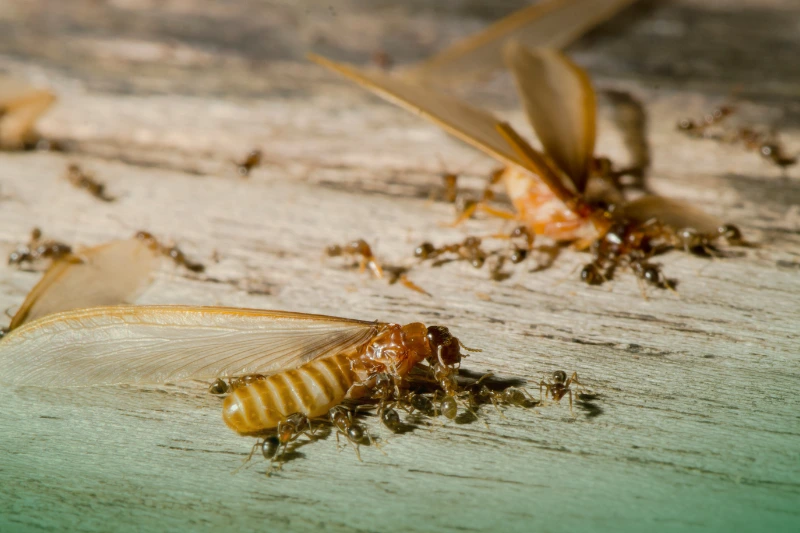
Ants and termites are often confused with one another, but they are actually quite different. While both are small insects that live in colonies, there are some key differences between the two.
One of the main differences between the two is their diet. Termites feed on wood and other cellulose-based materials, while ants do not. Ants are omnivores and will eat a variety of foods, including other insects, nectar, and seeds. This is why ants are often seen scavenging for food in homes and other buildings like wooden structures.
While both ants and termites can cause damage to homes and buildings, termites are much more destructive. This is because they feed on wood and other cellulose-based materials, while ants do not. Additionally, termites can go undetected for long periods, causing extensive damage before their presence is noticed.
In conclusion, while ants and termites may look similar at first glance, there are some key differences between the two. It’s important to be able to recognize the differences in order to properly identify and treat any infestations.
How Termites Cause Destruction?
Termites cause destruction by feeding on wood and other cellulose-based materials, such as paper and cardboard. They can weaken the structure of a building and cause significant damage if left unchecked.
Termites can be very difficult to detect, especially in the early stages of an infestation. This is why it’s important to have regular inspections by a professional pest control company. Early detection is key to preventing damage to your home or building.
Damage Caused by Termites
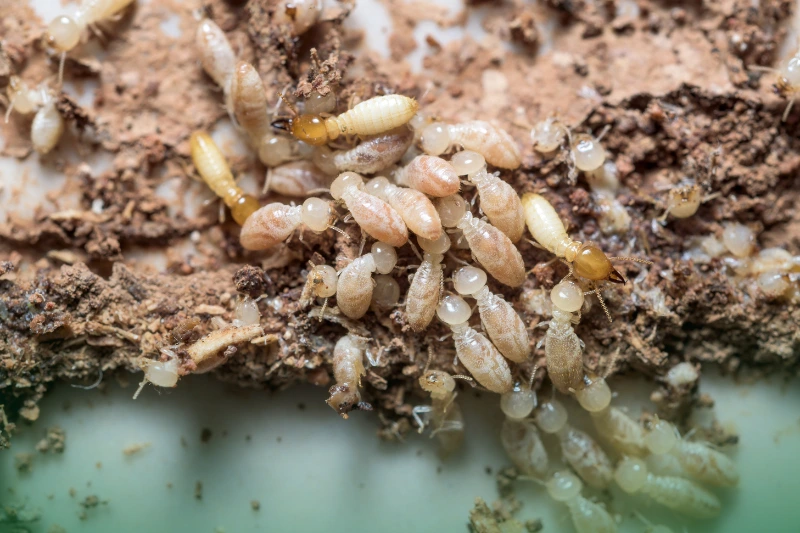
Termites can cause significant damage to structures made of wood, including homes, buildings, and furniture. They feed on wood, causing structural failure or damage and weakening the integrity of the building. Termites can also damage other cellulose-based materials, such as paper, cardboard, and some fabrics. The damage caused by termites can lead to costly repairs and, in severe cases, can even cause a building to become uninhabitable.
Termites are not just a problem in older homes or buildings. They can infest new constructions as well. In fact, there are cases where termites have been found in homes that are only a few months old. This is because termites can enter a building through small cracks or openings in the foundation or even through infested wood installed or placed in your new house or building. They can also enter through wood that is in contact with the soil. This is why it is essential to take steps to prevent termites from entering your home.
Signs of a Termite Infestation
Detecting termite infestations can be challenging because these pests often work within walls and other hidden areas. However, homeowners and business owners can look out for some tell-tale signs of termite activity.
One of the most common signs of a termite infestation is the presence of mud tubes on both interior and exterior of the building. These tubes, also known as tunnels, are used by termites to travel between their long-distance nest and their food source like wooden structures.
Another sign of termite activity is the presence of winged reproductives or also known as Alates leaving their discarded wings. After swarming, termites shed their wings, which can often be found near windowsills, floors, or other entry points.
Homeowners should also be on the lookout for wood that sounds hollow when tapped, as this can be a sign of termite damage. By being vigilant for these signs, homeowners and business owners can detect an infestation early and take action to prevent further damage to their houses or buildings.
Another sign of an infestation is drywood termite droppings, also known as frass, which are small, sand-like pellets that are often found near the areas where drywood termites are active. These droppings are typically a sign of drywood termite infestations and can accumulate over time, leading to potential health hazards and structural damages if left unchecked. It’s important to have a professional termite inspection and treatment to address the issue and prevent further termite damage.
How to Protect Your Home or Building
To protect your home or building from termite damages and infestations, you can take several preventative measures, including:
-
Regular inspections by a professional pest control company to detect and prevent termite damage and infestations
-
Store firewood or dry wood away from your home or building: Keep wood storage away from your house or building to avoid attracting termites.
-
Keep gutters and downspouts clean and free of debris: Prevent water buildup and moisture by keeping gutters and downspouts clean.
-
Fix leaks in pipes and faucets: Eliminate sources of moisture by repairing any leaks in pipes and faucets.
-
Ensure proper ventilation in attics and crawl spaces: Proper ventilation helps to reduce moisture buildup and minimize the risk of termite infestation.
-
Seal all cracks and openings in the foundation and walls: Seal any gaps and cracks in the foundation and walls to prevent termites from entering your house or building.
By taking these preventative measures, you can help ensure your property is protected from termite damages and potential infestations.
Prevention and Treatment
Preventing termite damage and infestation is essential, and it’s always easier and less expensive than treating one. Here are a few steps homeowners and business owners can take to prevent termites from entering their properties:
-
Eliminate any sources of standing water
-
Remove any wood-to-soil contact around the foundation
-
Seal any cracks and crevices or openings in the home’s exterior
In case of suspected termite damage or infestation, it’s important to contact a pest control professional right away. Treatment options for termite infestations include liquid termite treatments, bait stations, and fumigation. A pest control professional can help determine the best course of action for treating an infestation.
Treatment Options
Termites can cause significant damage to properties and wooden structures, but there are various treatment options available to control termite activity, ranging from pre-construction soil treatments to post-construction chemical treatments. In this blog post, we’ll explore some of the most effective termite control options to help you choose the right one for your needs.
If you are planning or building your property, we have several treatment options available for you. These include:

-
Termite Pre-construction Soil Treatment
– is a critical step in preventing subterranean termites from infiltrating your property. By taking this essential measure, you can avoid a potential termite problem before it even starts, especially during the early stages of construction. This recommendation is highly important to ensure that your house or building remains protected from these destructive pests.
-
Our termite treatment process involves two stages. Firstly, we apply termiticides to the foundation or footing of the structure using power sprayers. This is the first treatment, and it acts as a barrier between the soil and the foundation, preventing an infestation.
-
The second treatment involves applying termiticides to the flooring of the structure, again using power sprayers. This stage completes the barrier protection, ensuring that the flooring is protected from termite activity. With our effective two-stage process, your property will be fully protected from termite infestations.
-
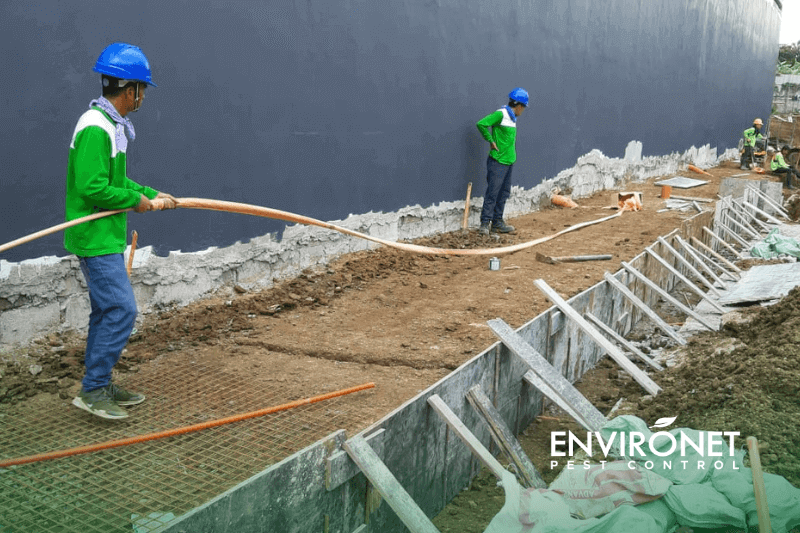
-
Termite Reticulation System
-is a highly effective termite control method designed to provide superior protection and control against these destructive pests. This innovative system consists of plastic pipes installed underground, which are impervious to termite damage.
Our termite control process involves two key steps: pipe installation and treatment.
- Firstly, we install UPVC pipes around the perimeter of the structure, using both flexible perforated pipes and non-perforated pipes. These pipes are strategically installed in the areas that require treatment, ensuring comprehensive coverage.
- Next, we charge termiticides onto the identified charging points within the pipes. This process ensures that the termiticide is distributed evenly throughout the soil and other areas susceptible to termite activity. With our comprehensive pipe installation and treatment process, your property will be well protected from termite damage.
If you already have termite infestations in your home or building, there are several treatment options available. These include:
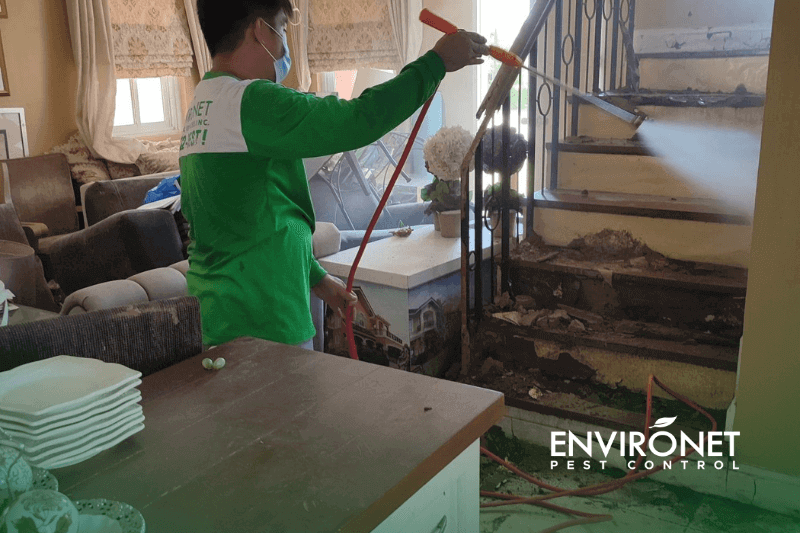
-
Termite Post-construction Chemical Treatment
-If your property’s foundation wasn’t treated before construction, it could be vulnerable to termite activity. To address this issue, you might consider a specialized service called Termite Post-Construction Chemical Treatment. This treatment involves using a liquid termiticide to eradicate active termite infestations and prevent further spread.
Our expert technicians apply the treatment to infested areas, wooden materials, and furniture on your property. Our goal is twofold: first, to eliminate the active termite infestation, and second, to prevent any future termite activity. With our post-construction termite treatment, you can have peace of mind knowing that your property is protected from these destructive pests.
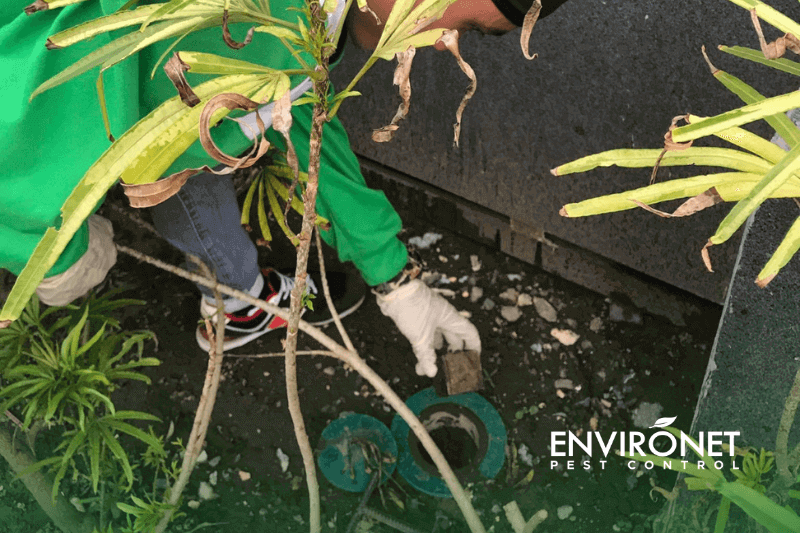
-
Termite Baiting System
– It is a method of eliminating termite infestation by placing baits around the property. These baits contain a substance that is toxic to termites, and when consumed, they can spread the poison to the rest of the colony.
Here are some of the treatments involved in the termite baiting system:
-
Installation of bait stations: Termite bait stations are installed around the perimeter of the property, where termite activity is present.
- Monitoring: Regular inspections are conducted to monitor termite activity and consumption of the bait.
- Bait replacement: The baits are replaced regularly to ensure their effectiveness.
-
Elimination of the colony: Once the bait is consumed, it can eliminate the entire termite colony, including the queen.
-
Termite baiting system is a less invasive and eco-friendly alternative to traditional treatments such as liquid termiticides and fumigation. It is effective in controlling termite infestation and can be used as a preventive measure to protect the property from future infestations. Professional pest control companies can provide expert advice and services for the installation and maintenance of termite baiting systems.

-
Termite Mound Demolition
– Termite mounds are structures built by termites to house their colonies. These mounds can vary in size and shape depending on the species of termite. These mounds are a clear indication of termite activity in the area.
Treatment for mounds or what we call Termite Mound Demolition typically involves the use of insecticides. The most effective treatment will depend on the type of termite and the severity of the infestation. It is important to seek the assistance of a professional pest control company for proper identification and treatment of these mounds to ensure the complete eradication of the infestation.
Protecting your property from termites requires specialized knowledge, information, and expertise. At Environet Pest Control, our team of experts is dedicated to providing comprehensive termite control services that are tailored to your unique needs. We understand the destructive nature of termites and the importance of preventing and treating infestations as early as possible.
When you choose us, we’ll begin with a FREE thorough inspection and identification of any infested areas. Then, we’ll install our advanced termite baiting system strategically to eliminate the infestation and protect your property from future damage. Our team will work with you every step of the way to ensure that you’re informed and confident in the treatment process.
Don’t risk the safety of your property or family by attempting termite treatments on your own. Contact Environet Pest Control today to learn more about our professional and effective termite treatment options.
Conclusion
Termites may be small, but they can cause big termite problems for homeowners and building owners in the Philippines. Knowing what termites are, how they cause destruction, and their impact on homes and buildings is important for protecting your property. Regular inspections by a professional pest control company, along with preventative measures, can help detect and prevent termite infestations. If you suspect that your property has a termite infestation or you want to prevent one from happening, it’s crucial to take action and work with a professional pest control company. At Environet Pest Control, we offer effective and customized termite control solutions that can help protect your property from damage and keep your family safe. Don’t let termites cause costly repairs or compromise your home’s structural integrity – contact us today to schedule a FREE inspection and learn more information about our termite treatments!
